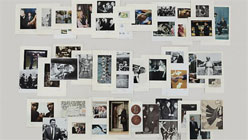For her first exhibition in San Francisco, photographer Taryn Simon delves into a unique archive to create a series of organized images about the organization of images. The Picture Collection contains photographs of the New York Public Library’s circulating image library, a collection of 1.2 million prints, photographs, posters, postcards, and illustrations. Within over 12,000 subject headings, Simon selected one folder at a time to spread out and photograph its contents. The resulting prints, squarely capturing the materials from above in what resemble analog search engine results, tread an intriguing line between impartial document and subjective presentation.
These large-scale photographs, hung throughout both floors of the John Berggruen Gallery, feature the contents of twenty different subject folders. So many of the elements in The Picture Collection are standardized (lighting within the photograph, scale within the photograph, size of the prints, type of framing and hanging apparatus) that smaller discrepancies emerge more dramatically over time spent in the exhibition.
In the wall text introducing this museum-like show, the NYPL Picture Collection is identified as a precursor to digital visual resources. By photographing the collection’s isolated organizational structures, Simon “highlights the invisible hands behind seemingly neutral systems of image gathering.” At the same time, she highlights her own hand, blurring the role of librarian and photographer. Is Simon presenting the whole folder or just part of it? Certain images are privileged with a position in the foreground; others are relegated to the background, emphasizing the subjectivity of the entire project. The compositions are artful, unique, and in the most satisfying moments of the show, linked directly to the content of the images.

Taryn Simon, The Picture Collection, installation view.
Folder: Express highways features photographs of cloverleaf interchanges, overpasses, and junctions all layered on top of each other in a centered mass. While other collections are displayed in neatly-defined rows, this grouping blends together into a confused system of roads, connected by their design and function within the American landscape. Similarly, Folder: Tug of war is arranged in two neat rows, mimicking its subject matter to create a continuous line of pulling across time and space.



